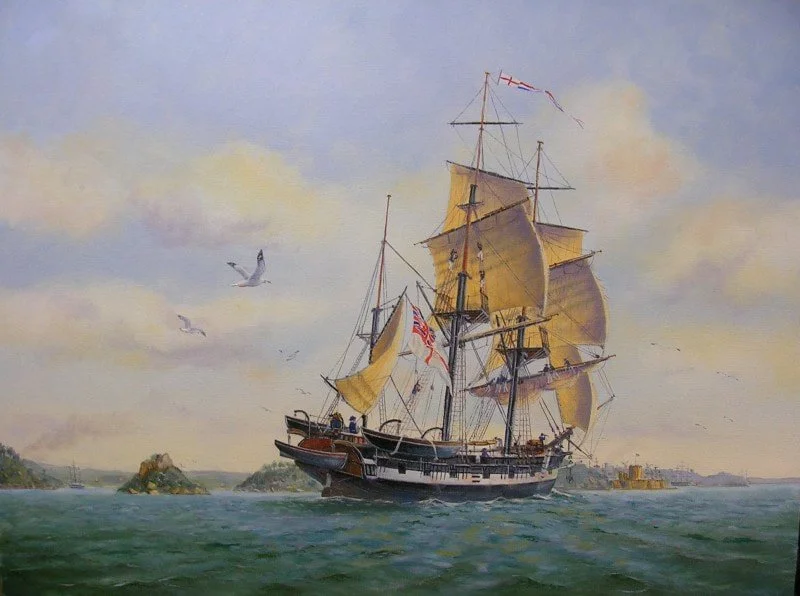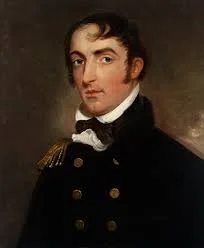Magistrate Wickham before Moreton Bay – the Beagle and the Tortoise
By Craig Coulsen (this article first appeared in HEARSAY in September 2023)
“Below 40 degrees South there is no law, and below 50 degrees South there is no God.“
19th Century whalers’ saying
HMS Beagle Sydney Harbour 1838 By Ron Scobie
Introduction
In the days before GPS Navigation, for a young ocean navigator there was no greater feeling of elation at the end of a rough passage to first see the loom of a lighthouse twenty-five miles distant.
The sighting was both vindication and validation of your judgement, skill, labours and sometimes luck. You, and your crew, were no longer lost in the world. You knew your position on the chart.
With the foregoing in mind, some would make a case that for the Bicentennial celebrations in 1988 the “Endeavour” replica was the wrong ship to build.
The ship equally significant in the establishment of the Australian colonies was the HMS Beagle. Much of the Australian coast was charted by survey of the crew of the “Beagle”. So much allowed the coast to be safely travelled.
And central to the story of the “Beagle” – for Australia – is not Charles Darwin but the man who later was appointed first Police Magistrate of Moreton Bay, John Wickham.
John Wickham
Before his appointment to Moreton Bay in January 1842, Wickham spent nearly 2 decades charting in Australian and South American waters, and most was aboard the “Beagle”. For the Australian colonies to develop, the coast needed charting to facilitate defence and commerce. Wickham, and John Lort Stokes, his successor as master of the “Beagle”, afforded that.
Even as late as 1983, the Hydrographic Office Chart “Approaches to Moreton Bay” utilised a “Beagle” survey.
The “Beagle”
The “Beagle” completed three great voyages but is generally remembered only for the second being “the Darwin voyage”.
“Beagle” was a “Cherokee” class sloop of which around one hundred and twenty were built. In many ways it was similar to the “Endeavour” but smaller, lighter and with less freeboard.
These were not good ships, but rather nicknamed “Coffin brigs” because of the tendency to capsize and sink. Yet not one was ever lost to enemy fire.
In modern terms, it was shorter in length than the super maxis that race in the Sydney to Hobart yacht race but weighed ten times as much and carried three times the crew.
In other words, it was hardly a vessel of choice to spend the best part of fifteen years surveying higher than 40 degrees south latitude.
That is the Southern Ocean, and for every mile of it Wickham was there first on the “Adventure” but mostly on the “Beagle”.
The First Voyage of the “Beagle”
Wickham, aged fourteen, joined the Royal Navy on the 21st of February 1812, served as a mid-shipman and was made Lieutenant in 1819. In 1825 as a Second Lieutenant, he was assigned to the “Adventure” under the command of Phillip Parker King, his later brother in law and Vice-Admiral in the Royal Navy.
The “Beagle, in the company of the “Adventure,” set out from England in May 1826 and did not return until October 1830.
In that four year period such vessels carried out a commission to chart the southern parts of South America and in particular Patagonia.
Wickham had chief command of a flotilla consisting of of the “La Liebre” and “La Paz”, two tenders chartered to undertake survey in confined waters of the Chilean Channels.
Until 1903, the Chilean Channels and Drake Passage were the only routes between the Pacific and Atlantic Oceans, so they were strategically important to the British Navy.
The “Beagle” and the “Adventure” spent over three years in Patagonia.
The charts of the Chilean Channels remain in use today. The original journals of the voyage are held not by the Royal Navy but its Chilean counterpart.
The Second Voyage of the “Beagle”
In 1831, after having served on the “Adventure”, Wickham was assigned to the “Beagle” under the command of Robert Fitzroy, along with his seagoing compatriot from the “Adventure” and close friend Parker King.
Naturalist Charles Darwin was a supernumerary on this voyage, having paid £500 for a passage for him and his 8 staff.
Fitzroy’s sailing instructions on this voyage had very little to do with the wishes of Darwin. Rather, he was directed to complete a full circumnavigation so as to establish meridians of longitude otherwise essential for accurate navigation.
In simple terms, latitude can be determined by comparing local noon time with the noon time at Greenwich being the prime meridian.
To this end, Fitzroy took aboard the “Beagle” twenty two chronometers to ensure accuracy and to counter redundancy.
Along the way, Fitzroy surveyed Patagonia, Peru, Galapagos, Samoa, Fiji, New Zealand, Port Jackson (now Sydney), Van Diemen’s Land (now Tasmania) and King George Sound.
The majority of the time was spent completing surveys of Chile, Peru and Patagonia and later Van Diemen’s Land. That task took until late 1836 with a very slow crossing of the Indian Ocean to the Cape Colony and return to England.
The first published book on the Second Voyage comprises four volumes of which only the third is written by Darwin, the first by Parker King and the balance by Fitzroy.
Darwin would later go on to publish his seminal work in November 1859.
For Wickham it was more of the same.
The Third Voyage of the “Beagle”
On 10 January 1837, Wickham was promoted to master of the “Beagle” and given fresh sailing instructions. His second in command was John Lort Stokes. In June 1837 the Beagle set off with instructions to chart North West Australia, Arnhem Land and the Cocos Islands.
Along the way the Beagle surveyed and charted much of North West Australia, as well as revisiting surveys of Bass Straight and South West Van Diemen’s Land.
Much of the mineral wealth of Australia is now exported through the waters Wickham and Lort Stokes first surveyed and charted on this voyage.
Wickham remained in command of the “Beagle” until mid 1841, after which he was appointed as the Police Magistrate of the Moreton Bay colony.
Lort Stokes – who after Wickham’s retirement from the sea took command of the “Beagle” – for the next decade surveyed and charted much of the North Australian Coast.
The Sea
What is astonishing about Wickham’s years at sea is that on the “Adventure”, the “La Liebre”, the “La Paz” and later the “Beagle” is that much of the time-consuming survey work was carried out below 40 degrees South, in the full teeth of the privations of the Southern Ocean.
Yet, on the whole, the ships rarely sustained damage, and illness was generally uncommon except for the Northern Australian surveys where the crew, and indeed Wickham, suffered terribly from the heat, poor rations and long periods at sea.
But there were close calls. Marsden Hordern – in his excellent work “Mariners are Warned” – describes the fourth great struggle with the Southern Ocean of the “Beagle”, and Wickham’s fine judgement:
The coastline of this part of Tasmania trends south-easterly and, even though carrying a heavy press of sail, the Beagle could only steer parallel with the shore on a course east of south. She could not escape to sea. It was fortunate that Wickham had not delayed his decision to run south for a few more hours. Had he done so, the westerly gale might have caught them near Cape Grim, where the coast trends outwards towards West Point, with its off-lying Porpoise Shoal. In that case the Beagle might not have survived her fourth struggle with the Southern Ocean.
All night long the Beagle battled. Toward morning, to their immense relief, the wind moved a little to the north-west, and as day broke the bold outline of South West Cape looming on the port bow, with a huge swell bursting at its foot. The Beagle had clawed free of its cliffs and won her fight by the slimmest margin. After clearing the cape, they altered course eastwards and, with the wind now fair, sailed swiftly on. At noon they passed between Tasman’s Maatsuyker Islands and the precipitous cliffs of the Mewstone – breeding place of the albatross, Stokes’s ‘monarch of the ocean’.
By sunset they were at the entrance to D’Entrecasteaux Channel abreast of Bruny Island, where Helpman was cheered by the sight of Sir John Franklin’s splendid lighthouse – a ‘fine bright revolving light’. The ship rounded Tasman Head and entered Storm Bay in the teeth of a foul wind. Sick of storms, Stokes decided that the bay’s character had not changed since Tasman named it in 1642.
It is one thing for modern day master mariner travelling through Patagonia or the South Tasman Sea – in a modern one hundred thousand tonne plus cruise or commercial ship, viewing from enclosed bridge – to navigate and marvel at the ferocity of a Southern Ocean gale. It is quite another thing to command from an open deck a ninety foot long two hundred tonne timber hulk, tasked with the safety of the vessel and sixty crew.
Small boat voyagers say that to get caught in one proper Southern Ocean gale is unlucky, but to survive three makes you the luckiest person on earth! Wickham must have survived dozens and not just in summer but at the depths of winter whether at sea or at anchor. His judgement as a seaman, and depth of spirit, to allow of survival must have been extraordinary. No doubt it equipped him well for the next phase of his life adjudicating legal disputes in the Moreton Bay colony.
So next time you traverse Wickham Terrace or Wickham Street (or attend the Wickham Hotel) in Brisbane, or stand on Wickham Point at Caloundra, take a moment to consider the life of Wickham, not just as a Magistrate – and later government resident – but as an extraordinary seaman and leader of crew in the most hostile conditions.
A case can be made that Wickham left Moreton Bay after his aspiration to be the new Colony’s first governor was quashed by the politics of others. In January 1864 at Biarritz, in South Western France, Wickham passed away in poor circumstances brought about when the colonies of New South Wales and Queensland engaged in a bitter dispute as to which colony was responsible for the payment of his pension.
He was safer at sea.
In Part Two, in the next edition of Hearsay, John Wickham’s time at the Moreton Bay colony will be addressed.
Post Script – Harriet the Tortoise and Star Trek
For those who consider history as something remote in time, there is something too in the extraordinary story of Harriet, the Galapagos tortoise.
On the second voyage, in 1835, after seeing Wickham ride a Galapagos tortoise, Darwin gave Wickham a gift of three, they then the size of a dinner plates (they grew!). Wickham named them “Tom”, “Dick” and “Harry” but later was obliged to rename the last “Harriet”. He brought them with him to Moreton Bay. When Wickham left Moreton Bay, “Harriet” remained to happily wander the grounds of Newstead House. She must have been looked after well by the locals.
The Galapagos tortiose enjoys superior longevity. “Harriet” finally passed, at Australia Zoo, in 2006 (no, not a mistake). See this link.
And to jump to film and the year 2262, the Starship “Beagle” was a small Class IV Stardrive Survey Vessel which appeared in Episode 14 of Series 2 of Star Trek which premiered on 15 March 1968.
NOTE: The Author is presently collecting materials so as to undertake a biography of Wickham.




